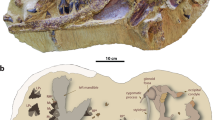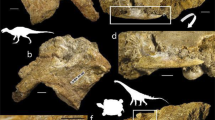Abstract
Although the first ten million years of whale evolution are documented by a remarkable series of fossil skeletons, the link to the ancestor of cetaceans has been missing. It was known that whales are related to even-toed ungulates (artiodactyls), but until now no artiodactyls were morphologically close to early whales. Here we show that the Eocene south Asian raoellid artiodactyls are the sister group to whales. The raoellid Indohyus is similar to whales, and unlike other artiodactyls, in the structure of its ears and premolars, in the density of its limb bones and in the stable-oxygen-isotope composition of its teeth. We also show that a major dietary change occurred during the transition from artiodactyls to whales and that raoellids were aquatic waders. This indicates that aquatic life in this lineage occurred before the origin of the order Cetacea.
This is a preview of subscription content, access via your institution
Access options
Subscribe to this journal
Receive 51 print issues and online access
$199.00 per year
only $3.90 per issue
Buy this article
- Purchase on Springer Link
- Instant access to full article PDF
Prices may be subject to local taxes which are calculated during checkout





Similar content being viewed by others
References
Milinkovitch, M. C., Bérubé, M. & Palsbøl, P. J. in The Emergence of Whales: Evolutionary Patterns in the Origin of Cetacea (ed. Thewissen, J. G. M.) 113–131 (Plenum, New York, 1998)
Nikaido, M., Rooney, A. P. & Okada, N. Phylogenetic relationships among cetartiodactyls based on insertions of short and long interspersed elements: Hippopotamuses are the closest extant relatives of whales. Proc. Natl Acad. Sci. USA 96, 10261–10266 (1999)
Gatesy, J. & O’Leary, M. A. Deciphering whale origins with molecules and fossils. Trends Ecol. Evol. 16, 562–570 (2001)
Boisserie, J.-R., Lihoreau, F. & Brunet, M. Origins of Hippopotamidae (Mammalia, Cetartiodactyla): towards resolution. Zool. Scr. 34, 119–143 (2005)
Thewissen, J. G. M., Williams, E. M., Roe, L. J. & Hussain, S. T. Skeletons of terrestrial cetaceans and the relationships of whales to artiodactyls. Nature 413, 277–281 (2001)
Theodor, J. M. & Foss, S. E. Deciduous dentitions of Eocene cebochoerid artiodactyls and cetartiodactyl relationships. J. Mammal. Evol. 12, 161–181 (2005)
O’Leary, M. A. in The Emergence of Whales: Evolutionary Patterns in the Origin of Cetacea (ed. Thewissen, J. G. M.) 133–161 (Plenum, New York, 1998)
Boisserie, J.-R., Lihoreau, F. & Brunet, M. The position of Hippopotamidae within Cetartiodactyla. Proc. Natl Acad. Sci. USA 102, 1537–1541 (2005)
Geisler, J. H. & Uhen, M. D. Morphological support for a close relationship between hippos and whales. J. Vertebr. Paleontol. 23, 991–996 (2003)
Geisler, J. H. & Uhen, M. D. Phylogenetic relationships of extinct Cetartiodactyls: results of simultaneous analyses of molecular, morphological, and stratigraphic data. J. Mammal. Evol. 12, 145–160 (2005)
Ranga Rao, A. New mammals from Murree (Kalakot zone) of the foot-hills near Kalakot, J & K State. J. Geol. Soc. India 12, 125–134 (1971)
Ranga Rao, A. & Misra, V. N. On the new Eocene mammal localities in the Himalayan foot-hills. Himalayan Geol. 11, 422–428 (1981)
Kumar, K. & Sahni, A. Eocene mammals from the Upper Subathu Group, Kashmir Himalaya, India. J. Vertebr. Paleontol. 5, 153–168 (1985)
Thewissen, J. G. M., Williams, E. M. & Hussain, S. T. Eocene mammal faunas from northern Indo-Pakistan. J. Vertebr. Paleontol. 21, 347–366 (2001)
Luo, Z. in The Emergence of Whales: Evolutionary Patterns in the Origin of Cetacea (ed. Thewissen, J. G. M.) 269–301 (Plenum, New York, 1998)
Luo, Z. & Gingerich, P. D. Terrestrial Mesonychia to aquatic Cetacea: transformation of the basicranium and evolution of hearing in whales. Univ. Mich. Pap. Paleontol. 31, 1–98 (1999)
Thewissen, J. G. M & Williams, E. M. The early radiations of Cetacea (Mammalia): evolutionary pattern and developmental correlations. Annu. Rev. Ecol. Syst. 33, 73–90 (2002)
O’Leary, M. A. & Uhen, M. D. The time of origin of whales and the role of behavioral changes in the terrestrial–aquatic transition. Paleobiology 25, 534–556 (1999)
Nummela, S., Hussain, S. T. & Thewissen, J. G. M. Cranial anatomy of Pakicetidae (Cetacea, Mammalia). J. Vertebr. Paleontol. 26, 746–759 (2006)
Gray, N. M., Kainec, K., Madar, S., Tomko, L. & Wolfe, S. Sink or swim? Bone density as a mechanism for buoyancy control in early cetaceans. Anat. Rec.: Adv. Int. Anat. Evol. Biol. 290, 638–653 (2007)
Madar, S. I. The postcranial skeleton of early Eocene pakicetid cetaceans. J. Paleontol. 81, 176–200 (2007)
Roe, L. J. et al. in The Emergence of Whales: Evolutionary Patterns in the Origin of Cetacea (ed. Thewissen, J. G. M.) 399–422 (Plenum, New York, 1998)
Clementz, M. T., Goswami, A., Gingerich, P. D. & Koch, P. L. Isotopic records from early whales and sea cows: contrasting patterns of ecological transition. J. Vertebr. Paleontol. 26, 355–370 (2006)
Francillon-Vieillot, H. et al. in Skeletal Biomineralization Patterns, Processes, and Evolutionary Trends (ed. Carter, J. G.) 471–530 (Van Nostrand Reinhold, New York, 1990)
de Buffrénil, V., Ricqlès, A., Ray, C. E. & Domning, D. P. Bone histology of the ribs of the archaeocetes (Mammalia: Cetacea). J. Vertebr. Paleontol. 10, 455–466 (1990)
Kaiser, H. E. Untersuchungen zur vergleichenden Osteologie der Fossilen und rezenten Pachyostosen. Palaeontographica A 114, 113–196 (1960)
Domning, D. P. & de Buffrénil, V. Hydrostasis in the Sirenia: quantitative data and functional interpretations. Mar. Mamm. Sci. 7, 331–368 (1991)
Fish, F. E. & Stein, B. R. Functional correlates of differences in bone density among terrestrial and aquatic genera in the family Mustelidae (Mammalia). Zoomorphology 110, 339–345 (1991)
Wall, W. P. The correlation between high limb-bone density and aquatic habitats in recent mammals. J. Paleontol. 57, 197–207 (1983)
Taylor, M. A. Functional significance of bone ballast in the evolution of buoyancy control strategies by aquatic tetrapods. Histor. Biol 14, 15–31 (2000)
Koch, P. L., Tuross, N. & Fogel, M. L. The effects of sample treatment and diagenesis on the isotopic integrity of carbonate in biogenic hydroxyapatite. J. Archaeol. Sci. 24, 417–429 (1997)
Kohn, M. J. Predicting animal δ18O: accounting for diet and physiological adaptation. Geochim. Cosmochim. Acta 60, 4811–4829 (1996)
Clementz, M. T. & Koch, P. L. Differentiating aquatic mammal habitat and foraging ecology with stable isotopes in tooth enamel. Oecologia 129, 461–472 (2001)
Bocherens, H., Koch, P. L., Mariotti, A., Geraads, D. & Jaeger, J.-J. Isotopic biogeochemistry (13C, 18O) of mammalian enamel from African Pleistocene hominid sites. Palaios 11, 306–318 (1996)
Bryant, J. D. & Froelich, P. N. A model of oxygen isotope fractionation in body water of large mammals. Geochim. Cosmochim. Acta 59, 4523–4537 (1995)
Jim, S., Ambrose, S. H. & Evershed, R. P. Stable carbon isotopic evidence for differences in the dietary origin of bone cholesterol, collagen and apatite: Implications for their use in palaeodietary reconstruction. Geochim. Cosmochim. Acta 68, 61–72 (2004)
Cloern, J. E., Canuel, E. A. & Harris, D. Stable carbon and nitrogen isotope composition of aquatic and terrestrial plants of the San Francisco Bay estuarine system. Limnol. Oceanogr. 47, 713–729 (2002)
Osmond, C. B., Valaane, N., Haslam, S. M., Uotila, P. & Roksandic, Z. Comparisons of δ13C values in leaves of aquatic macrophytes from different habitats in Britain and Finland; some implications for photosynthetic processes in aquatic plants. Oecologia 50, 117–124 (1981)
O’Leary, M. H. Carbon isotopes and photosynthesis. Bioscience 38, 328–336 (1988)
Dubost, G. Un aperçu sur l’écologie du chevrotain africain Hyemoschus aquaticus Ogilby, artiodactyle tragulide. Mammalia 42, 1–62 (1978)
Ducrocq, S. The late Eocene Anthracotheriidae (Mammalia, Artiodactyla) from Thailand. Palaeontographica A 252, 93–140 (1999)
Ducrocq, S. Unusual dental morphologies in late Eocene anthracotheres (Artiodactyla, Mammalia) from Thailand: dental anomalies and extreme variations. N. Jb. Geol. Paläont. MH 4, 199–212 (1999)
Suteethorn, V., Buffetaut, E., Helmcke-Ingavat, R., Jaeger, J. J. & Jongkanjanasoontorn, Y. Oldest known Tertiary mammals from South East Asia: middle Eocene primate and anthracotheres from Thailand. N. Jb. Geol. Paläont. MH 9, 563–570 (1988)
Colbert, E. H. Fossil mammals from Burma. Am. Mus. Nat. Hist. Bull. 74, 419–424 (1938)
Brunet, M. M. Découverte d’un crâne d’Anthracotheriidae, Microbunodon minimum (Cuvier), á La Milloque (Lot-et-Garonne). C. R. Acad. Sci. Paris 267, 835–838 (1968)
Lihoreau, F., Blondel, C., Barry, J. & Brunet, M. A new species of the genus Microbunodon (Anthracotheriidae, Artiodactyla) from the Miocene of Pakistan: genus revision, phylogenetic relationships and palaeobiogeography. Zool. Scr. 33, 97–115 (2004)
Bajpai, S. et al. Early Eocene land mammals from Vastan Lignite Mine, District Surat, Gujarat, western India. J. Palaeontol. Soc. India 50, 101–113 (2005)
West, R. M. Middle Eocene large mammal assemblage with Tethyan affinities, Ganda Kas region, Pakistan. J. Paleontol. 54, 508–533 (1980)
Acknowledgements
We thank the late F. Obergfell for presenting us with the sediment blocks containing Indohyus fossils collected by A. Ranga Rao for preparation and study; D. S. N. Raju and N. Raju for facilitating our research; B. Armfield, R. Conley and A. Maas for fossil preparation; J. Dillard for preparing Fig. 5; and J. Geisler and J. Theodor for providing additional information about their cladistic analyses. Laboratory research was funded by the National Science Foundation (NSF) – Earth Sciences (grants to J.G.M.T. and M.T.C.). Collaborative work was funded by the Indian Department of Science and Technology (to S.B.) and the NSF – International Division (to J.G.M.T.) under the Indo-US Scientific Cooperation Program. Laboratory analyses were supported by the Skeletal Biology Research Focus Area of Northeastern Ohio Universities College of Medicine.
Author Contributions J.G.M.T. was responsible for anatomical and systematic study, and scientific synthesis, L.N.C. for systematic and bone density study, M.T.C. for the study of stable isotopes, and S.B. and B.N.T. for geological study and collecting of Indohyus and comparative fossil samples.
Author information
Authors and Affiliations
Corresponding author
Supplementary information
Supplementary Information
The file contains Supplementary Methods, Supplementary Results, Supplementary Tables 1-5 and additional references. (PDF 1088 kb)
Rights and permissions
About this article
Cite this article
Thewissen, J., Cooper, L., Clementz, M. et al. Whales originated from aquatic artiodactyls in the Eocene epoch of India. Nature 450, 1190–1194 (2007). https://doi.org/10.1038/nature06343
Received:
Accepted:
Issue Date:
DOI: https://doi.org/10.1038/nature06343
This article is cited by
-
Patterns of enrichment and acceleration in evolutionary rates of promoters suggest a role of regulatory regions in cetacean gigantism
BMC Ecology and Evolution (2023)
-
A heavyweight early whale pushes the boundaries of vertebrate morphology
Nature (2023)
-
The molecular evolution of genes previously associated with large sizes reveals possible pathways to cetacean gigantism
Scientific Reports (2023)
-
Subaqueous foraging among carnivorous dinosaurs
Nature (2022)
-
Extensive Interspecific Gene Flow Shaped Complex Evolutionary History and Underestimated Species Diversity in Rapidly Radiated Dolphins
Journal of Mammalian Evolution (2022)
Comments
By submitting a comment you agree to abide by our Terms and Community Guidelines. If you find something abusive or that does not comply with our terms or guidelines please flag it as inappropriate.



